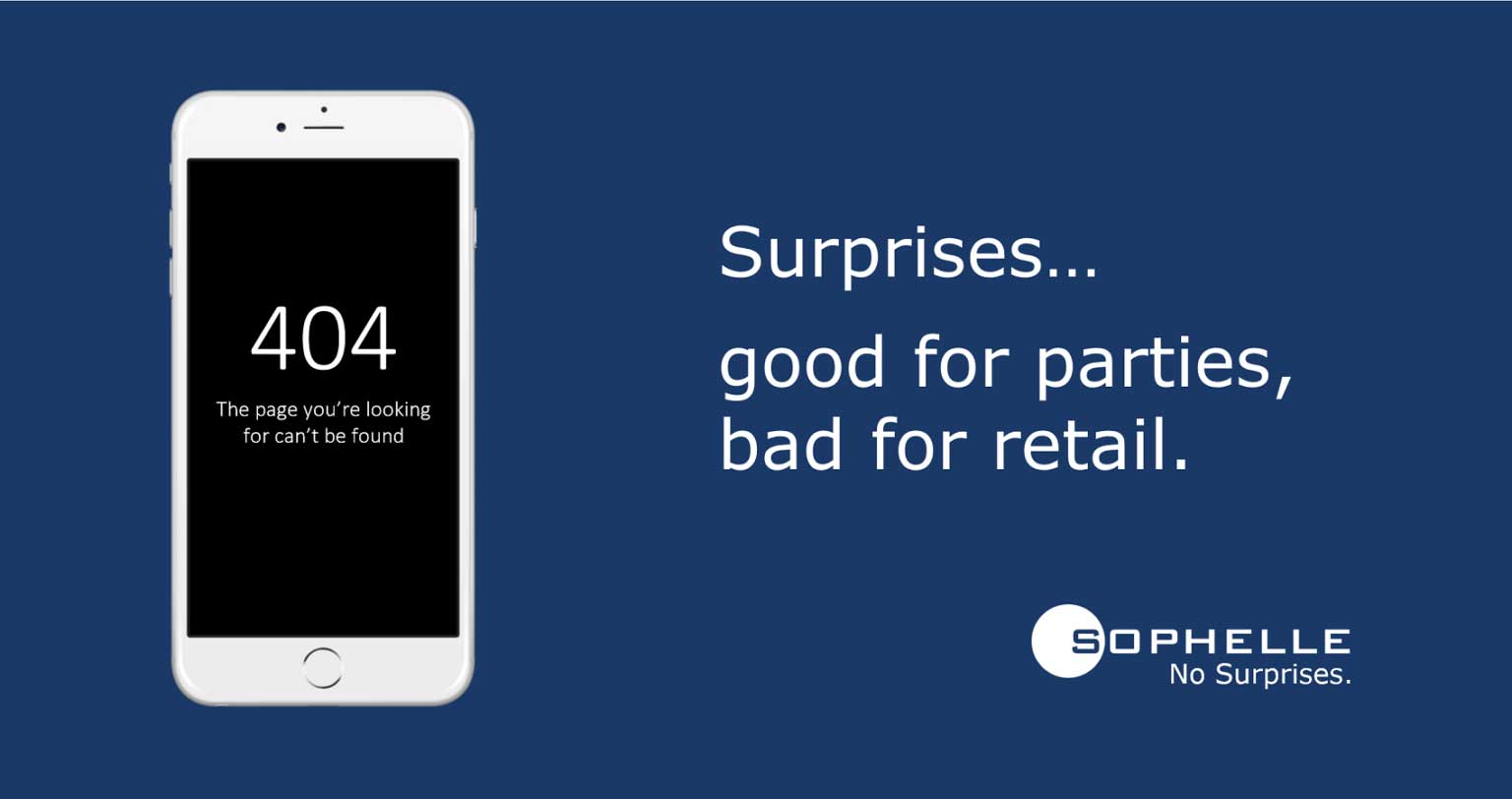No one likes surprises at work. We want to make plans, execute against them, and meet or exceed our customers’ expectations. This is even more the case today in retail. Customers don’t want surprises. They don’t want to arrive at a store and see it’s closed. They don’t want to find out an item is out of stock. They don’t want late deliveries, higher than expected prices, slower than expected websites. They want their expectations met. In our new normal, certainty is a valuable commodity.
Sophelle has helped hundreds of leading retailers on strategy, selection, implementation, and optimization projects. Our clients have delighted their customers, not by surprising them, but by consistently meeting and exceeding expectations. And customers are rewarding retailers who deliver on promises.
We first developed our No Surprises approach for internal operations. During a meeting with one of our clients, I explained the details of our approach. She asked a number of probing questions to make sure that it was real, and not just sales-speak. After hearing me out she said, “That’s what I want! I want to promise my business users No Surprises. How do we get started?”
No Surprises is an integral part of the Sophelle culture. It’s the foundation of every project. It’s woven into every process. It’s on the back of our business cards. It’s the most repeated phrase in the company. We’ve gone to these lengths because our No Surprises approach has proven successful on hundreds of projects.
Sophelle’s No Surprises approach is built on the following principles and tactics.
No Surprises Principle: Shared Expectations
Ensure all project stakeholders know what’s going to happen on the project and why.
Tactic #1: Create detailed business and technical requirements
“Start with the end in mind” was Stephen Covey’s second habit of highly effective people. The key to No Surprises is to define the “end in mind” in detail. The less left to interpretation, the fewer possible surprises.
Tactic #2: Set reasonable plans with time to react to project issues
Stretch goals can deliver extraordinary success, but the more aggressive the goals the more likely there are to be surprises. Open, candid communication is required to make sure all project participants believe plans are reasonable.
Tactic #3: Get commitments for time, budget, and specifications
Plans without commitments are wishes. Get commitments from all accountable participants.
No Surprises Principle: Operational Discipline
Facilitate repeatable success. Success without discipline is luck.
Tactic #4: Leverage deep domain expertise
The majority of retail projects have been previously executed by other people and other companies. Don’t reinvent the wheel. Engage project resources with relevant experience and expertise to avoid relearning lessons and repeating mistakes.
Tactic #5: Leverage project management best practices
Proper project management should be considered the foundation of every project. More rigor is required for more complex projects, but every project should follow baseline standards. Project charters, RASI charts, and written status updates can be simplified, but shouldn’t be skipped.
Tactic #6: Leverage change management best practices
Most retail projects don’t fail due to technology. Most retail projects fail due to poor change management. Change management frameworks such as ADKAR, Kotter, and Satir offer proven methodologies and tools.
Tactic #7: Leverage quality & risk management best practices
Quality assurance and testing efforts and investments need to be proportional to risk. Risk management determines what risks exist and facilitates handling those risks in the most appropriate manner.
No Surprises Principle: Complete Transparency
Maintain trust and minimize the impact of inevitable events. Transparency is what prevents events from being surprises.
Tactic #8: Set up a framework and cadence for clear, structured, and frequent communications
Templates allow for quick reporting and color-coded updates allow for quick review and understanding of project status. Written, phone, virtual, and in-person communications should be scheduled at set intervals.
Tactic #9: Demand objectivity and transparency in progress and status reporting
It’s often too easy for project participants to present rosy, best-case assessments of their progress and plans. Project stakeholders should feel free to question assumptions and aspects that are concerning. Those reporting on project updates should be responsive, supportive, and non-defensive in addressing stakeholders’ concerns.
Tactic #10: Focus on early identification and escalation of project risks and issues
Don’t allow “wait and see” attitudes. Address potential problems early and head on. Set the expectation and there may be false alarms, but delays on reporting risks will not be tolerated.
Sophelle Can Help
The tactics provided above are starting points in addressing an organization’s ability to change. Sophelle has helped hundreds of leading retailers for 25 years. For more information and help, please contact Sophelle today.
This is the fourth in a four-part series on how retailers can come out of the COVID crisis best positioned to succeed in the future.
Part 1 “Begin Planning Now”
Part 2 “Agility Is Oxygen TM”
Part 3 “10 Tactics to Make Innovation Happen”
Click here to subscribe to Sophelle’s newsletter for first access to all of Sophelle’s thought leadership and updates on retail industry news and events.




